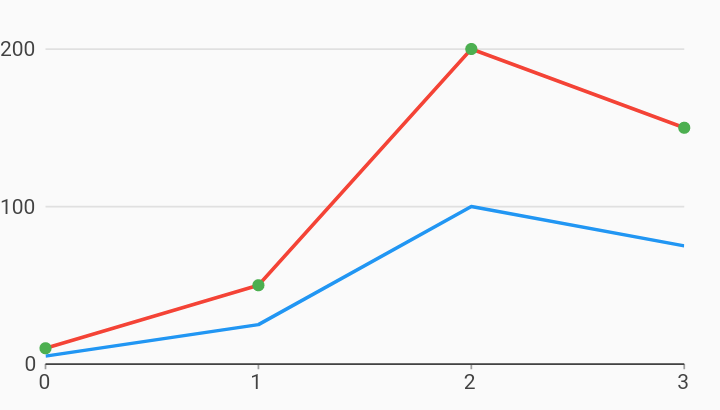charts
Numeric Line Point Combo Chart Example

Example:
/// Example of a numeric combo chart with two series rendered as lines, and a
/// third rendered as points along the top line with a different color.
///
/// This example demonstrates a method for drawing points along a line using a
/// different color from the main series color. The line renderer supports
/// drawing points with the "includePoints" option, but those points will share
/// the same color as the line.
import 'package:charts_flutter/flutter.dart' as charts;
import 'package:flutter/material.dart';
class NumericComboLinePointChart extends StatelessWidget {
final List<charts.Series> seriesList;
final bool animate;
NumericComboLinePointChart(this.seriesList, {this.animate});
/// Creates a [LineChart] with sample data and no transition.
factory NumericComboLinePointChart.withSampleData() {
return new NumericComboLinePointChart(
_createSampleData(),
// Disable animations for image tests.
animate: false,
);
}
@override
Widget build(BuildContext context) {
return new charts.NumericComboChart(seriesList,
animate: animate,
// Configure the default renderer as a line renderer. This will be used
// for any series that does not define a rendererIdKey.
defaultRenderer: new charts.LineRendererConfig(),
// Custom renderer configuration for the point series.
customSeriesRenderers: [
new charts.PointRendererConfig(
// ID used to link series to this renderer.
customRendererId: 'customPoint')
]);
}
/// Create one series with sample hard coded data.
static List<charts.Series<LinearSales, int>> _createSampleData() {
final desktopSalesData = [
new LinearSales(0, 5),
new LinearSales(1, 25),
new LinearSales(2, 100),
new LinearSales(3, 75),
];
final tableSalesData = [
new LinearSales(0, 10),
new LinearSales(1, 50),
new LinearSales(2, 200),
new LinearSales(3, 150),
];
final mobileSalesData = [
new LinearSales(0, 10),
new LinearSales(1, 50),
new LinearSales(2, 200),
new LinearSales(3, 150),
];
return [
new charts.Series<LinearSales, int>(
id: 'Desktop',
colorFn: (_, __) => charts.MaterialPalette.blue.shadeDefault,
domainFn: (LinearSales sales, _) => sales.year,
measureFn: (LinearSales sales, _) => sales.sales,
data: desktopSalesData,
),
new charts.Series<LinearSales, int>(
id: 'Tablet',
colorFn: (_, __) => charts.MaterialPalette.red.shadeDefault,
domainFn: (LinearSales sales, _) => sales.year,
measureFn: (LinearSales sales, _) => sales.sales,
data: tableSalesData,
),
new charts.Series<LinearSales, int>(
id: 'Mobile',
colorFn: (_, __) => charts.MaterialPalette.green.shadeDefault,
domainFn: (LinearSales sales, _) => sales.year,
measureFn: (LinearSales sales, _) => sales.sales,
data: mobileSalesData)
// Configure our custom point renderer for this series.
..setAttribute(charts.rendererIdKey, 'customPoint'),
];
}
}
/// Sample linear data type.
class LinearSales {
final int year;
final int sales;
LinearSales(this.year, this.sales);
}